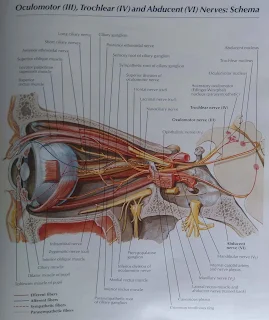CRANIAL NERVES
There are 12 pairs of
cranial nerves originating from nuclei in the inferior surface of the brain,
some sensory, some motor and some mixed.
Their names and numbers are:
- I. Olfactory: sensory
- II. Optic: Sensory
- III. Oculomotor : motor
- IV. Trochlear: motor
- V: Trigeminal: mixed
- VI: Abducent: motor
- VII. Facial: mixed
- VIII. Vestibulocochlear (auditory): sensory
- IX. Glossophranyngeal: mixed
- X. Vagus: mixed
- XI. Accessory: motor
- XII. Hypoglossal: motor.
I. OLFACTORY NERVES (SENSORY)

- These are the nerves of the sense of smell.
- Their sensory receptors and fibers originate in the upper part of the mucous membrane of the nasal cavity, pass upwards through the cribriform plate of the ethmoid boned and then go to the olfactory bulb.
- The nerves then proceed backwards as the olfactory tract, to the area for the perception of smell in the temporal lobe of the cerebrum.
II. OPTIC NERVES (SENSORY)
- These are the nerves of the sense of sight.
- The fibres originate in the retinae of the eyes and they combine to form the optic nerves.
- They are directed backwards and medially through the posterior part of the orbital cavity. They then pass through the optic foramina of the sphenoid bone into the cranial cavity and join at the optic chiasma.
- The nerves proceed backwards as the optic tracts to the lateral geninculate bodies of the thalamus.
- Impulses pass from these to the centre for sight in the occipital lobes of the cerebrum and to the cerebellum.
- In the occipital lobe sight is perceived, and in the cerebellum the impulses from the eyes contribute to the maintenance of balance, posture and orientation of the head in space.
III. OCULOMOTOR NERVES (MOTOR)
- These nerves arise from nuclei near the cerebral aqueduct. They supply:
- . Four of the six extrinsic muscles, which move the eyeball, i.e. the superior, medial and inferior recti and the inferior oblique muscle.
- . the intrinsic (intraocular) muscles:
- - ciliary muscles, which alter the shape of the lens, changing its refractive power
- - circular muscles of the iris, which constrict the pupil
- . the levator palpebrae muscles, which rise the upper eyelids.
IV. TROCHLEAR NERVES (MOTOR)
- These nerves rise from nuclei near the cerebral aqueduct.
- They supply the superior oblique muscles of the eyes.
V. TRIGEMINAL NERVES (MIXED)
- These nerves contain motor and sensory fibers and are among the largest of the cranial nerves. They are the chief sensory nerves for the face and head (including the oral and nasal cavities and teeth), receiving impulses of pain, temperature and touch.
- The motor fibres stimulate the muscles of mastication.
- As the name suggests, there are three main branches of the trigeminal nerves.
- The dermatomes innervated by the sensory fibres on the right side.
- The ophthalmic nerves are sensory only and supply the lacrimal glands, conjunctiva of the eyes, forehead, eyelids, anterior aspect of the scalp and mucous membrane of the nose.
- The maxillary nerves are sensory only and supply the cheeks, upper gums, upper teeth and lower eyelids.
- The mandibular nerves contain both sensory and motor fibres.
- These are the largest of the three divisions and they supply the teeth and gums of the lower jaw, pinnae of the ears, lower lip and tongue.
- The motor fibres supply the muscles of mastication.
VI. ABDUCENT NERVES (MOTOR)
These nerves arise
from nuclei lying under the floor of the fourth ventricle.
They supply the
lateral rectus muscles of the eyeballs.
VII. FACIAL NERVES (MIXED)
These nerves are
composed of both motor and sensory nerve fibres, arising from nuclei in the lower
part of the pons.
The motor fibres supply the muscles o facial expression.
The
sensory fibres convey impulses from the taste buds in the anterior two-thirds
of the tongue to the taste perception area in the cerebral cortex.
VIII. VESTIBULOCOCHLEAR (AUDITORY) NERVES (SENSORY)
These nerves are
composed of two distinct sets of fibres, vestibular nerves and cochlear nerves.
The vestibular nerves
arise from the semicircular canals of the inner ear and convey impulses to the
cerebellum.
They are associated with the maintenance of posture and balance.
The cochlear nerves
originate in the spiral organ (of Corti) in the inner ear and convey impulses
to the hearing areas in the cerebral cortex where sound is perceived.
IX. GLOSSOPHARYNGEAL NERVES (MIXED)
- The motor fibres arise from nuclei in the medulla oblongata and stimulate the muscles of the tongue and pharynx and the secretory cells of the parotid (salivary) glands.
- The sensory fibres convey impulses to the cerebral cortex from the posterior third of the tongue, the tonsils and pharynx and from taste buds in the tongue and pharynx.
- These nerves are essential for the swallowing and gag reflexes.
X. VAGUS NERVES (MIXED)
- These nerves have a more extensive distribution than any other cranial nerves.
- They pass down through the neck into the thorax and the abdomen.
- These nerves from an important part of the parasympathetic nervous system.
- The motor fibres arise from nuclei in the medulla and supply the smooth muscle and secretory glands of the pharynx, larynx, trachea, heart, oesophagus, stomach, intestines, exocrine pancreas, gall bladder, bile ducts, spleen, kidneys, ureter and blood vessels in the thoracic and abdominal cavities.
- The sensory fibres convey impulses from the membranes lining the same structures to the brain.
XI. ACCESSORY NERVES (MOTOR)
- These nerves arise from nuclei in the medulla oblongata and in the spinal cord.
- The fibres supply the sternocleidomastoid and trapezius muscles.
- Branches join the vagus nerves and supply the pharyngeal and laryngeal muscles.
XII. HYPOGLOSSAL NERVES (MOTOR)
- These nerves arise from nuclei in the medulla oblongata.
- They supply the muscles of the tongue and muscles surrounding the hyoid bone and contribute to swallowing and speech.

















1 Comments
Before people said there is no cure for herpes virus but today many people have now believe that there is a cure, herpes virus can be cured through Africans roots and herbs, Dr Itua Herbal Center he is the one of the great herbal doctor in Africa and he has the cure on this virus last month he share his herbal medicine in some medical hospital and now he is well recognize as one of the best in Africa, you don’t have to be sad any more or share your tears any more on this virus or other diseases when the cure have already be find by Dr Itua email him on drituaherbalcenter@gmail.com or https://www.drituaherbalcenter.com
ReplyDelete